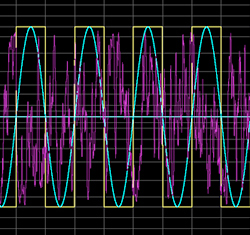
Many loudspeakers can withstand short, transient peaks of very high voltage. This will depend on the frequency content and time duration of the peaks as well as the loudspeaker design.
It is always best to check with the manufacturer first or test the peak capabilities of the loudspeaker yourself before deploying such a system.
There are several items that one should keep in mind, in addition to the ones already mentioned, when sizing an amplifier with this method:
1) The spectral content of the program material is very important. If it is not similar to IEC268 noise one should conduct a toaster test on the loudspeaker in question with 6 dB crest factor noise of the appropriate spectrum. The reason for this is two-fold.
—a) If there is too much voltage supplied to a loudspeaker driver in the frequency region close to or below its resonance frequency the excursion of the driver may exceed its safe operating limits. This could result in mechanical damage to the driver. A peak output capabilities test is also very helpful in this regard.
—b) If there is not enough voltage supplied to a loudspeaker driver in the frequency region close to its resonance frequency, relative to the overall RMS voltage, there may not be sufficient motion of the voice coil to adequately cool it. This could result in thermal damage to the driver.
2) When using larger amplifiers it is important to not allow them to be over driven and clip. This can increase the RMS voltage delivered to the loudspeaker and exceed its max Vrms.
3) A decrease in the crest factor of the program material, due to either compression or different program material, may result in a greater RMS voltage delivered to the loudspeaker than its max Vrms.
This will occur when the amplifier is driven just to, but not beyond, the point of clipping with a signal having a lower crest factor. This may result in the response of the loudspeaker changing by more than 3 dB and also possible damage to the loudspeaker.
Care should be taken in the system design to minimize the possibility of this occurring. Both RMS and peak limiters with appropriate time constants may be useful in this respect.
We have examined a method to help determine the required amplifier size so that a given loudspeaker reproducing a given signal may achieve a target SPL at a specified distance and shown an example of how to calculate this.
We have also touched on some of the reasons why one must be careful when driving loudspeakers with the very large amplifiers that may result from employing this method.
I hope this method will be useful to those designing and deploying sound reinforcement and playback systems.
Charlie Hughes has worked at Peavey Electronics and Altec Lansing. He currently heads up Excelsior Audio Design & Services; a consultation, design and measurement services company based near Charlotte, NC. Charlie is a member of the AES, ASA, CEA and NSCA. He is an active member of several AES and CEA standards committees.
